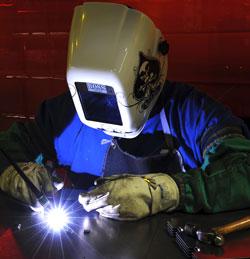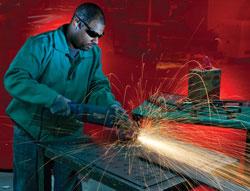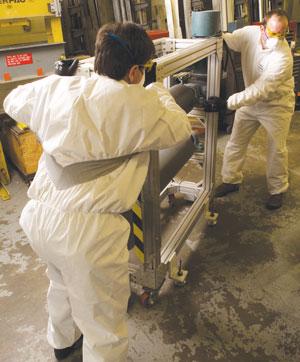Manufacturing Segment Marketing Manager
- FMA
- The Fabricator
- FABTECH
- Canadian Metalworking
Categories
- Additive Manufacturing
- Aluminum Welding
- Arc Welding
- Assembly and Joining
- Automation and Robotics
- Bending and Forming
- Consumables
- Cutting and Weld Prep
- Electric Vehicles
- En Español
- Finishing
- Hydroforming
- Laser Cutting
- Laser Welding
- Machining
- Manufacturing Software
- Materials Handling
- Metals/Materials
- Oxyfuel Cutting
- Plasma Cutting
- Power Tools
- Punching and Other Holemaking
- Roll Forming
- Safety
- Sawing
- Shearing
- Shop Management
- Testing and Measuring
- Tube and Pipe Fabrication
- Tube and Pipe Production
- Waterjet Cutting
Industry Directory
Webcasts
Podcasts
FAB 40
Advertise
Subscribe
Account Login
Search
How manufacturers can accommodate the needs of an aging work force
Keeping them safe and healthy keeps organizations productive and vibrant
- By Gina Tsiropoulos
- September 13, 2010
- Article
- Shop Management

In the U.S., close to 78 million people are considered baby boomers, those born from 1946 to 1964. It is estimated that all but the youngest of the boomers will reach retirement age by 2018. As a result, those in the metal fabricating industries soon may be faced with a labor shortage of huge proportions.
The American Welding Society, for example, estimates that more than half of this industry’s highly trained work force is nearing retirement, creating a potential shortage of more than 200,000 skilled welders this year alone (see Figure 1). This represents almost 40 percent of the total work force.
The labor shortage caused by the retirement of so many older manufacturing workers is compounded by another demographic shift: A majority of younger workers are looking toward white-collar, nonmanufacturing positions. That leaves manufacturers in a jam because many of the jobs held by retiring trade workers are highly skilled positions that cannot be automated.
Given this, successful companies need to both support their existing employee base and also design and implement programs to attract and retain new workers. In fact, as these demographic trends progress, public and private employment policies certainly will need to evolve to encourage workers to stay on the job longer. This approach can benefit management as well as employees becausebusinesses that successfully establish age-friendly workplaces have been shown to increase safety, productivity, and competitiveness.1
Managing Workplace Demographics
In response to these demographic shifts, managers must assess their companies’ work force to determine near- and long-term impacts on their businesses. Managers must first determine the gaps they will have when employees retire in large numbers. If too many employees retire and they are difficult to replace, the ability to make products or to deliver services may be compromised. Manufacturersthat plan ahead—to transfer skills and recruit new workers—will have an advantage over competitors.
As a first step, management should review employee data by plant and job function to determine work force levels and age distribution. They should look at the skills needed for each job function and the amount of time it takes to transfer that knowledge to other employees. At this point, companies will be able to identify their greatest areas of exposure.
Next, management should develop a program to transfer knowledge from older workers to younger ones. They should determine the level of training and time required for each job; some jobs may require only a few weeks to train, while others may take up to 18 months. Advance planning is essential for jobs that require longer training periods so that no significant gaps in labor appear.2
For example, at one Kimberly-Clark commercial machinery plant in Neenah, Wis., plant leadership has created a student co-op program for several students to work while they are going to vocational college. This gives the students a chance to gain hands-on experience, while introducing the plant to new skilled labor candidates.
Safety Among Older Workers
In addition to managing the age and skill differences of workers, manufacturers also must customize programs and policies to ensure the safety of their aging work force.
Jobs in manufacturing plants can be both mentally and physically demanding. A manufacturing environment also presents potential dangers that require workers to be constantly aware of their surroundings and follow safety precautions. At a typical metal manufacturing facility, for example, workers may be exposed daily to sharp metal shards, high levels of ambient noise, dangerous IR/UV lightconditions, and potentially hazardous chemicals or gases.
Although older workers tend to get injured less often, the injuries they sustain are often harder to recover from and keep them away from work for longer periods of time. Workers 65 years and older experience a longer absence from work with a median of 16 days, compared to six days away from work for workers age 25-34.
The Bureau of Labor Statistics (BLS) reports that the most common injuries to manufacturing workers in 2008 were:
- Sprains, strains, and tears, accounting for 62,840 cases, or 34 percent of all manufacturing-related injuries.
Median days away from work: eight.
- Cuts and lacerations, 18,770 cases, or 10 percent of injuries.
Median days away from work: four.
- Fractures, 16,800 cases, or 9 percent of injuries. Median days away from work: 30.
- Bruises and contusions, 15,320 cases, or 8 percent of injuries.
Median days away from work: four.
For older workers, the BLS notes, the percentage suffering a sprain, strain, or tear declines as the percentage suffering a fracture increases.
The cost to manufacturers of workplace injuries and illnesses extends far beyond the medical costs to treat the ailment. Manufacturers also need to consider the costs associated with lost productivity, administrative time, insurance costs, Occupational Safety and Health Administration involvement, media attention, company reputation, and employee morale. The costs for even a minor injury canbe staggering.

Health Changes in Aging Workers
In addition to the common injuries manufacturing workers suffer, aging by itself brings changes to all parts of the body, from a decline in brain cell connections to a decrease in muscle mass. Bone density, exercise capacity, visual acuity, and resistance to heat and cold stress also decline with age.3 Aging can also decrease information processing time or speed, working memory, attentionabilities, and perceptual abilities. Decreases in senses, such as hearing and/or vision, and requirements for higher thresholds of perception may be related to an increase in falls (up to about 40 percent in people older than 60).4 Also, sensitivity to pain caused by hot objects may be reduced, increasing the risk of injury in cases where thermal shielding is required.5
Therefore, employers must consider the changes in a worker’s body when determining the best employee for physically demanding tasks.
What Manufacturers Can Do
Manufacturers can implement an ergonomics task force made up of employees in roles ranging from safety to engineering. This group is charged with constantly identifying ergonomic stressors and presenting options for mitigation that may include changes in work processes or exercise programs and health screenings.
A company can investigate the possibility of investing in a formal program that is designed to prevent injuries and boost safe behavior both at work and at home. These programs provide concrete strategies and skills for workers to take personal control of their own safety. Participants learn simple yet powerful techniques to improve balance, leverage, and position, which increase safety whilereducing strain and the wear and tear of work—important considerations for older workers.
Another way to protect older workers is to review personal protective equipment (PPE) purchases. Company management should be sure workers have protective eyewear (see Figure 2) that can be worn over glasses or investigate prescription safety glasses. It also needs to be certain that other types of PPE, such as gloves, coveralls, and respirators, are comfortable and fit well.Both help drive compliance, which will help reduce injuries for all workers.
Management also can monitor changes in each worker’s abilities by conducting annual health screenings. This enables the company to create a health baseline and monitor changes each year. Annual health screenings can include aerobic capacity tests, hearing and vision tests, and respiratory fit tests. Some respirator suppliers provide fit-test equipment and guidance for these purposes.
Levels of employee participation in health screenings vary from plant to plant, but some manufacturing companies have seen up to 70 percent participation. Participation increases if a company has a strong safety culture, if management actively supports the effort, and if the health screens are conducted during paid time. Through financial incentive programs, such as passing around “safetydollars” that can then be used to purchase items like bike helmets or on-site exercise equipment, participation may increase as well.
In addition to annual health screenings, employers need to promote health and safety on a regular basis. Those workplaces that achieve the highest levels of safety have done so by creating a culture that embraces safety and empowers employees to maintain a commitment to safety in everything they do. The key is to establish a safety-based culture that starts at the top and promotes thatcommitment with a passion, down and through the entire organization.

Below are some additional recommendations to help promote healthy work environments, particularly for older workers:
- Offer extra vacation days for employees who exercise regularly.
- Encourage employees to stretch before a shift.
- Add tasks to a given workstation that requires the employee to change positions more frequently.
- Design the workstations so that arms are kept below shoulder level and avoid repetitive motions requiring reaching above the head.
- Design jobs so that older workers do not have to exert as much physical force in material handling operations (see Figure 3). Restrict the maximum load for workers 45 years of age and older to 20 percent of the maximum load recommended for their younger co-workers.6
- Offer job sharing or part-time schedules for older workers.
- Have experienced workers demonstrate how to wear PPE and explain the risks of noncompliance to younger workers.
With 330 U.S. baby boomers turning 60 every hour, according to the U.S. Census Bureau, a significant portion of the work force is retiring or will soon be retiring. Successful companies will be those that are able to manage a blended work force and keep employees working productively while ensuring that knowledge and skills are transferred to new workers through recruitment and trainingprograms. Managing the health and safety of current workers as they age will create a positive and safe work environment for experienced workers, keeping them safe and on the job, as well as for younger workers who join the work force.
Notes
1. M. Silverstein, M.D., “Meeting the challenges of an aging work force,“ American Journal of Industrial Medicine (2008).
2. S. Rainer, J. Baier, and A. Fahlander, “Managing demographic risk,“ Harvard Business Review (February 2008).
3. M. Silverstein, M.D., “Meeting the challenges of an aging work force.”
4. T. Ogawa et al, “Effects of aging, sex and physical training on cardiovascular response to exercise,“ Circulation, 86 (1992), pp. 494-503.
5. J.J. Pirkl, “Transgenerational design: Prolonging the American dream generations,“ The Journal of the American Society of Aging, XIX (Spring 1995), pp. 1-14.
6. R.W. Boyce, “An ergonomic approach to the aging work force: Utilizing this valuable resource to best advantage by integrating ergonomics, health promotion, and employee assistance programs,“ Journal of Workplace Behavioral Health, 23(1⁄2) (2008), pp. 179-199.
Some Smart Moving Tips
Below are some recommendations for preventing lifting injuries from the MoveSMART program created by Strategic Safety Associations Inc., Portland, Ore.:
1. Stay in good shape. Well-conditioned muscles, especially abdominals, help support your back when you lift.
2. Avoid twisting; move gradually. Twisting, jerking, and rapid motions increase muscle stress.
3. Plan your route. Choose a clear path to avoid tripping and slipping.
4. Keep surroundings safe. Provide sufficient space for lifting and keep floors clean.
5. Use a stable method of reaching high shelves.
6. Lift comfortably. Remember to keep the load’s center of gravity close to your body, and bend your knees.
7. Get help. Lift only what you can handle.
8. Place frequently handled items at waist level.
9. Take a break. Repetitive lifting can cause muscle fatigue and injury.
About the Author
Gina Tsiropoulos
1400 Holcomb Bridge Road
Roswell, GA 30076
800-255-6401
subscribe now

The Fabricator is North America's leading magazine for the metal forming and fabricating industry. The magazine delivers the news, technical articles, and case histories that enable fabricators to do their jobs more efficiently. The Fabricator has served the industry since 1970.
start your free subscription- Stay connected from anywhere

Easily access valuable industry resources now with full access to the digital edition of The Fabricator.

Easily access valuable industry resources now with full access to the digital edition of The Welder.

Easily access valuable industry resources now with full access to the digital edition of The Tube and Pipe Journal.
- Podcasting
- Podcast:
- The Fabricator Podcast
- Published:
- 04/16/2024
- Running Time:
- 63:29
In this episode of The Fabricator Podcast, Caleb Chamberlain, co-founder and CEO of OSH Cut, discusses his company’s...
- Industry Events
16th Annual Safety Conference
- April 30 - May 1, 2024
- Elgin,
Pipe and Tube Conference
- May 21 - 22, 2024
- Omaha, NE
World-Class Roll Forming Workshop
- June 5 - 6, 2024
- Louisville, KY
Advanced Laser Application Workshop
- June 25 - 27, 2024
- Novi, MI































